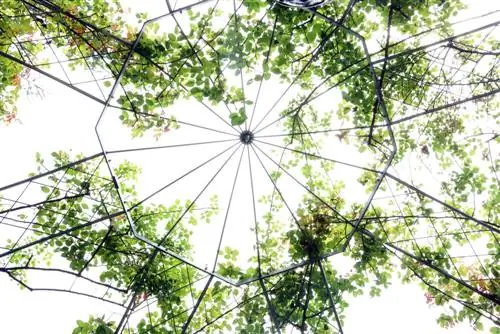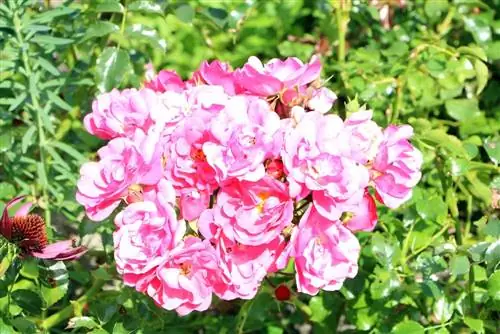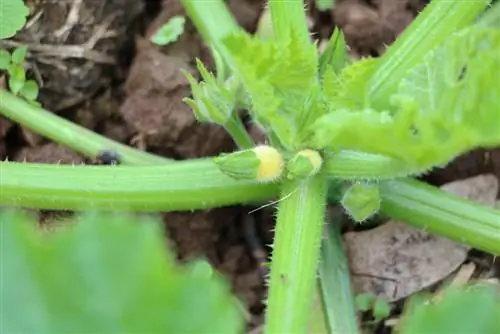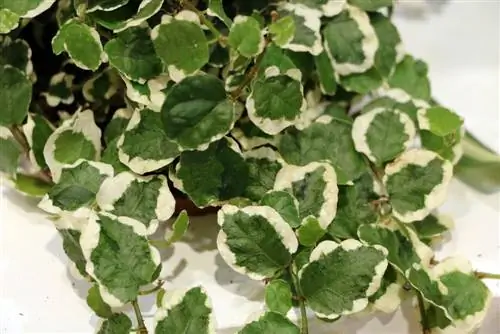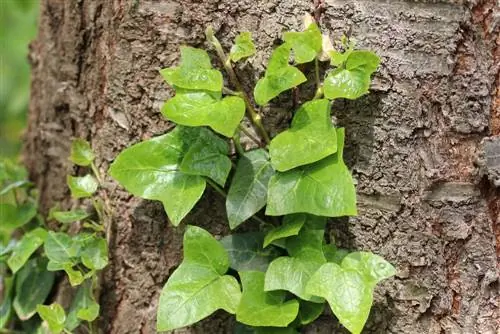- Author admin [email protected].
- Public 2023-12-17 03:39.
- Last modified 2025-01-24 12:45.
Climbing roses can be used to achieve particularly attractive visual effects in gardens. With their magnificent flowers and their relentless upward striving, they always attract attention. Once you have survived the somewhat problematic initial phase after planting, caring for the divas is no longer a major challenge. And for the winter there are now some varieties that are quite hardy.
Location
Success in cultivating climbing roses depends crucially on choosing the right location. If you do everything right here, not much can go wrong afterwards. Therefore, the choice of location should be carefully considered and correspond as closely as possible to the needs of the plants. Two things are particularly important: Firstly, the location must be as sunny as possible. And secondly, you need a place where a climbing aid fits.
Sun
Like all roses, climbing roses are true sun worshipers. They need a lot of light to be able to grow and develop their flowers. At the same time, the sun and especially the midday sun should not be able to burn down on them with full force. A location facing south, southeast or southwest is ideal if the sunlight is not too strong and there is protection from the midday sun. However, the place where the climbing roses are to be placed does not have to be completely protected from the wind - roses generally need good ventilation.
Climbing aid
Anyone who brings climbing roses into their garden should be aware that the plants cannot climb on their own. Rather, they absolutely need a so-called climbing aid, along which they can grow upwards. There must therefore be enough space for such a climbing aid at the chosen location. House or shed walls facing south are perfect. A free-standing gate or a specially displayed “climbing wall” can also be useful.
Planting substrate
In general, roses grow on almost any soil. In order to achieve optimal results, some basic conditions must be met. Above all, climbing roses require significantly more nutrient-rich soil. It is therefore advisable to mix the garden soil at the location in advance with plenty of humus or compost. It is generally important that the soil is very loose. The loosening before planting should be done to a depth of around 60 cm, as climbing roses also have deep roots. The ideal pH value of the soil ranges from 6.8 to 7.8. If these values are not achieved, some lime should be added.
Planting
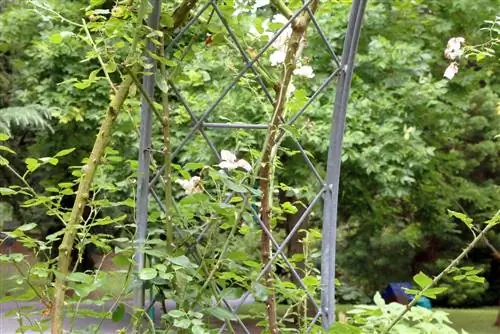
Once the right location has been found and the soil has been prepared accordingly, it's time to plant. Good planning is helpful here. The main question that needs to be clarified is how many rose bushes should actually be planted. The planting distance can be derived from this. For example, if a wall is to be planted as tightly as possible, the rose bushes must also be as close together as possible. A distance of around 50 cm is appropriate in such a case. The best time to plant climbing roses is autumn, ideally October. When planting, proceed as follows:
- Wet the roots well before planting, water the roots of bare-root climbing roses for at least one night
- Dig out the planting hole, the grafting point on the rose bush determines the depth - it should be about three fingers wide under the ground
- shorten both the roots and the branches in the upper area by a third
- Carefully place the plant in the planting hole without bending the roots
- water well before filling
- Fill the planting hole with soil and press the soil firmly.
Immediately after planting, you can start preparing the young plants for winter. The area around its base is well covered with mulch, leaves or brushwood.
Tip:
Ice-cold water should never be used when watering the freshly planted climbing roses. Rather, it should be at room temperature.
Pouring
Immediately after planting, the climbing rose must be regularly supplied with sufficient water. Drying out of the soil must be avoided at all costs. However, once the plant is well rooted, you no longer have to worry much about the water supply. Thanks to its long, deep roots, it essentially supplies itself with water. However, this does not apply in summer. Then you have to water at least once a week in the morning or evening. Ideally, you should start directly at the base and not pour over the leaves.
By the way:
The water requirement is limited even in hot summers. Overwatering should definitely be avoided.
Fertilize
Climbing roses can reach enormous heights. Of course, this only works if you have the energy for it. And that in turn means that they must be supplied with sufficient nutrients during the growth phase. There is no way around regular fertilization. Fertilization can be done with both artificial fertilizer and organic fertilizer. So you either get synthetic rose fertilizer from a gardening store and administer it according to the manufacturer's instructions, or you spread a mixture of compost and horn shavings around the trunk. The latter, i.e. the organic version, is generally clearly preferred by climbing roses.
Cutting
Many hobby gardeners dread cutting roses. However, there is not the slightest reason for this. Pruning roses and climbing roses is much less complicated than many people think. For climbing roses, the strong branches on the trellis should first be aligned in the desired direction. Once a year, all new side shoots are cut back so severely that only a few eyes remain. For climbing roses that bloom once, this is done after flowering; more continuously blooming roses are best done in spring. Any dead wood that is present should also be removed. A garden shear that is as sharp and clean as possible is ideal for this.
Tip:
As soon as flowers have withered, they should be removed immediately. This greatly promotes new bud formation.
Winter-hardy varieties
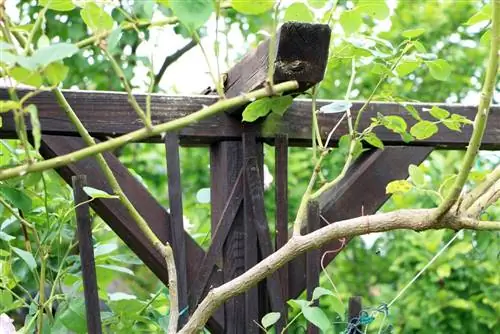
Opinions often differ when it comes to the question of whether climbing roses are actually hardy. In principle they are, but it depends on the winter. Extremely cold winters with lots of frost can therefore have a huge impact on plants. Regardless of the variety, the climbing rose bushes should be well covered with mulch, leaves, brushwood or a net during the winter months. If you really want to be on the safe side, it's best to get varieties that are considered particularly robust. Here is a small list of varieties that cope well or very well with winter conditions. The note “top” in brackets means that this is a very robust variety:
- Aloha
- Amadeus
- Facade magic
- Golden Gate (top)
- Guirlande d’Amour (top)
- Jasmina
- Kir Royal
- Momo
- Rosanna
- Rosarium Uetersen (top)
All of these varieties are frequent bloomers and grow to between 2, 5 and three meters tall. They have different flower colors. In addition, these ten varieties are characterized by high resistance to diseases and pests.
Overwintering in the plant pot
Anyone who has decided to cultivate one or more climbing roses in a planter instead of in the garden will of course also have to think about overwintering, regardless of the variety chosen. If the planter is to remain outdoors during the cold season, it must be packed well.
It is also recommended to place it on an insulating surface if possible. A thick Styrofoam plate is perfect for this. If it is possible to overwinter the bucket in the house, you must choose a place that is as cool as possible. In addition, watering should not be forgotten during this time. However, special protective packaging is not required.

